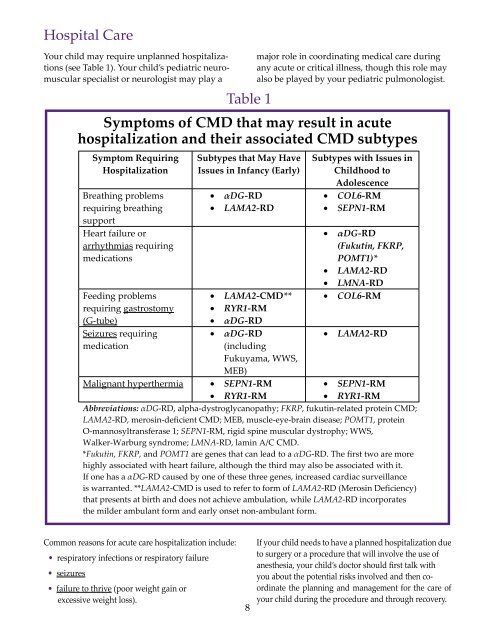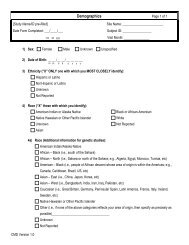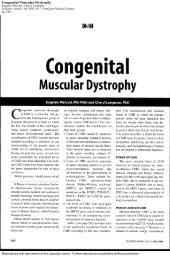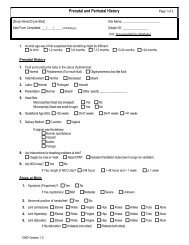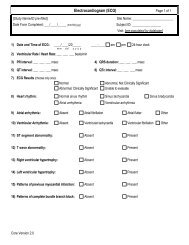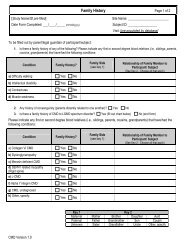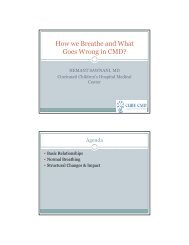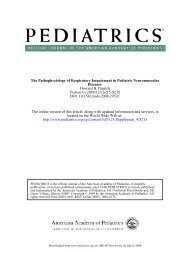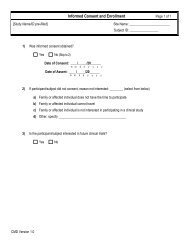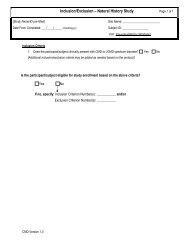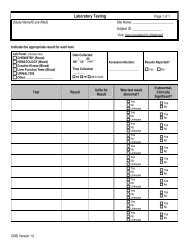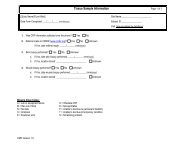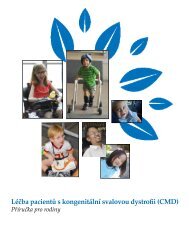The Management of Congenital Muscular Dystrophy ... - Cure CMD
The Management of Congenital Muscular Dystrophy ... - Cure CMD
The Management of Congenital Muscular Dystrophy ... - Cure CMD
Create successful ePaper yourself
Turn your PDF publications into a flip-book with our unique Google optimized e-Paper software.
Hospital CareYour child may require unplanned hospitalizations(see Table 1). Your child’s pediatric neuromuscularspecialist or neurologist may play amajor role in coordinating medical care duringany acute or critical illness, though this role mayalso be played by your pediatric pulmonologist.Symptoms <strong>of</strong> <strong>CMD</strong> that may result in acutehospitalization and their associated <strong>CMD</strong> subtypesSymptom RequiringHospitalizationBreathing problemsrequiring breathingsupportHeart failure orarrhythmias requiringmedicationsSubtypes that May HaveIssues in Infancy (Early)Table 1DG-RDLAMA2-RDFeeding problems LAMA2-<strong>CMD</strong>**requiring gastrostomy RYR1-RM(G-tube) DG-RDSeizures requiring DG-RDmedication(includingFukuyama, WWS,MEB)Malignant hyperthermia SEPN1-RM RYR1-RMSubtypes with Issues inChildhood toAdolescence COL6-RM SEPN1-RMDG-RD(Fukutin, FKRP,POMT1)*LAMA2-RDLMNA-RDCOL6-RMLAMA2-RDSEPN1-RMRYR1-RMAbbreviations: DG-RD, alpha-dystroglycanopathy; FKRP, fukutin-related protein <strong>CMD</strong>;LAMA2-RD, merosin-deficient <strong>CMD</strong>; MEB, muscle-eye-brain disease; POMT1, proteinO-mannosyltransferase 1; SEPN1-RM, rigid spine muscular dystrophy; WWS,Walker-Warburg syndrome; LMNA-RD, lamin A/C <strong>CMD</strong>.*Fukutin, FKRP, and POMT1 are genes that can lead to a DG-RD. <strong>The</strong> first two are morehighly associated with heart failure, although the third may also be associated with it.If one has a DG-RD caused by one <strong>of</strong> these three genes, increased cardiac surveillanceis warranted. **LAMA2-<strong>CMD</strong> is used to refer to form <strong>of</strong> LAMA2-RD (Merosin Deficiency)that presents at birth and does not achieve ambulation, while LAMA2-RD incorporatesthe milder ambulant form and early onset non-ambulant form.Common reasons for acute care hospitalization include:• respiratory infections or respiratory failure• seizures• failure to thrive (poor weight gain orexcessive weight loss).8If your child needs to have a planned hospitalization dueto surgery or a procedure that will involve the use <strong>of</strong>anesthesia, your child’s doctor should first talk withyou about the potential risks involved and then coordinatethe planning and management for the care <strong>of</strong>your child during the procedure and through recovery.


